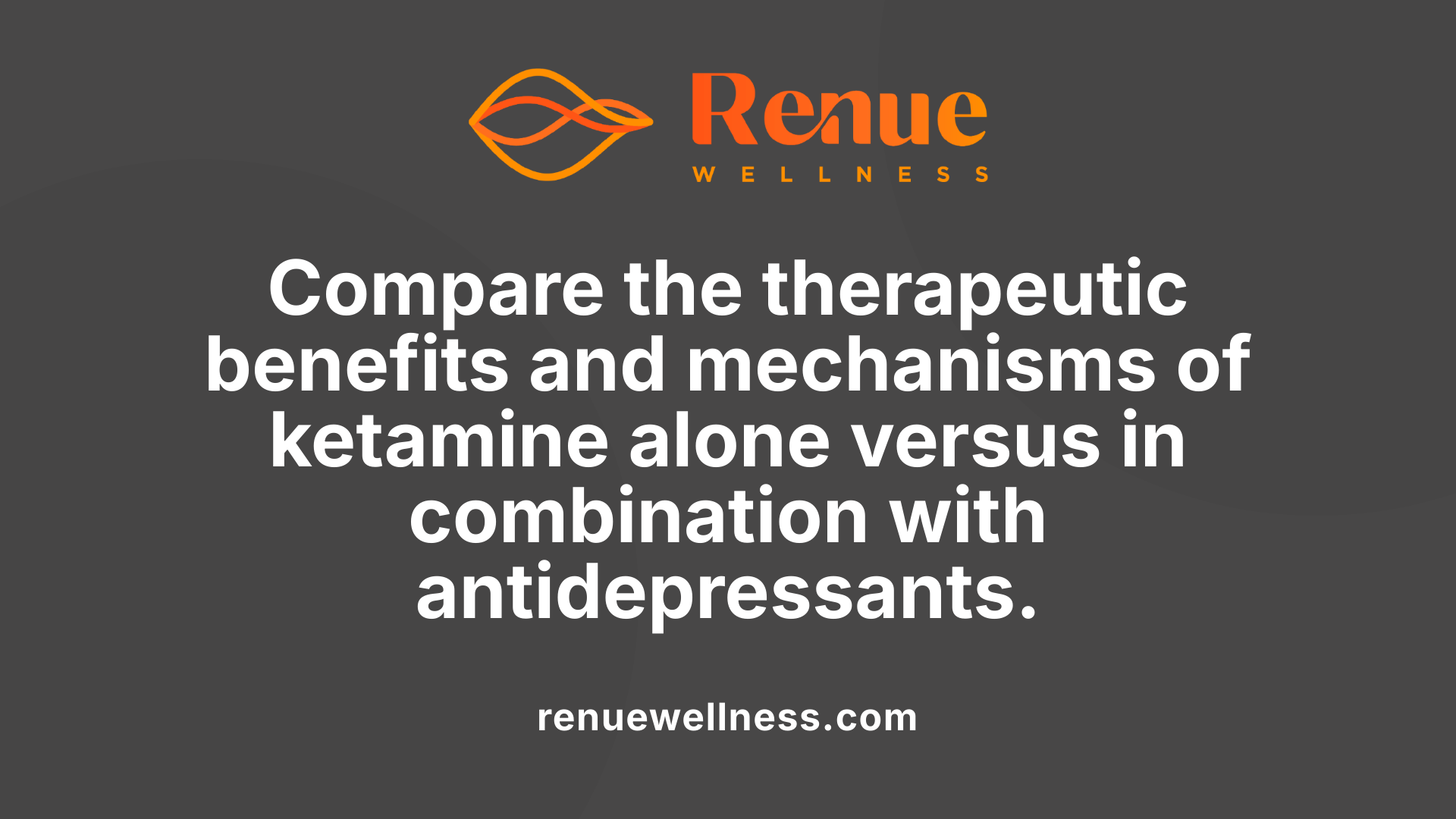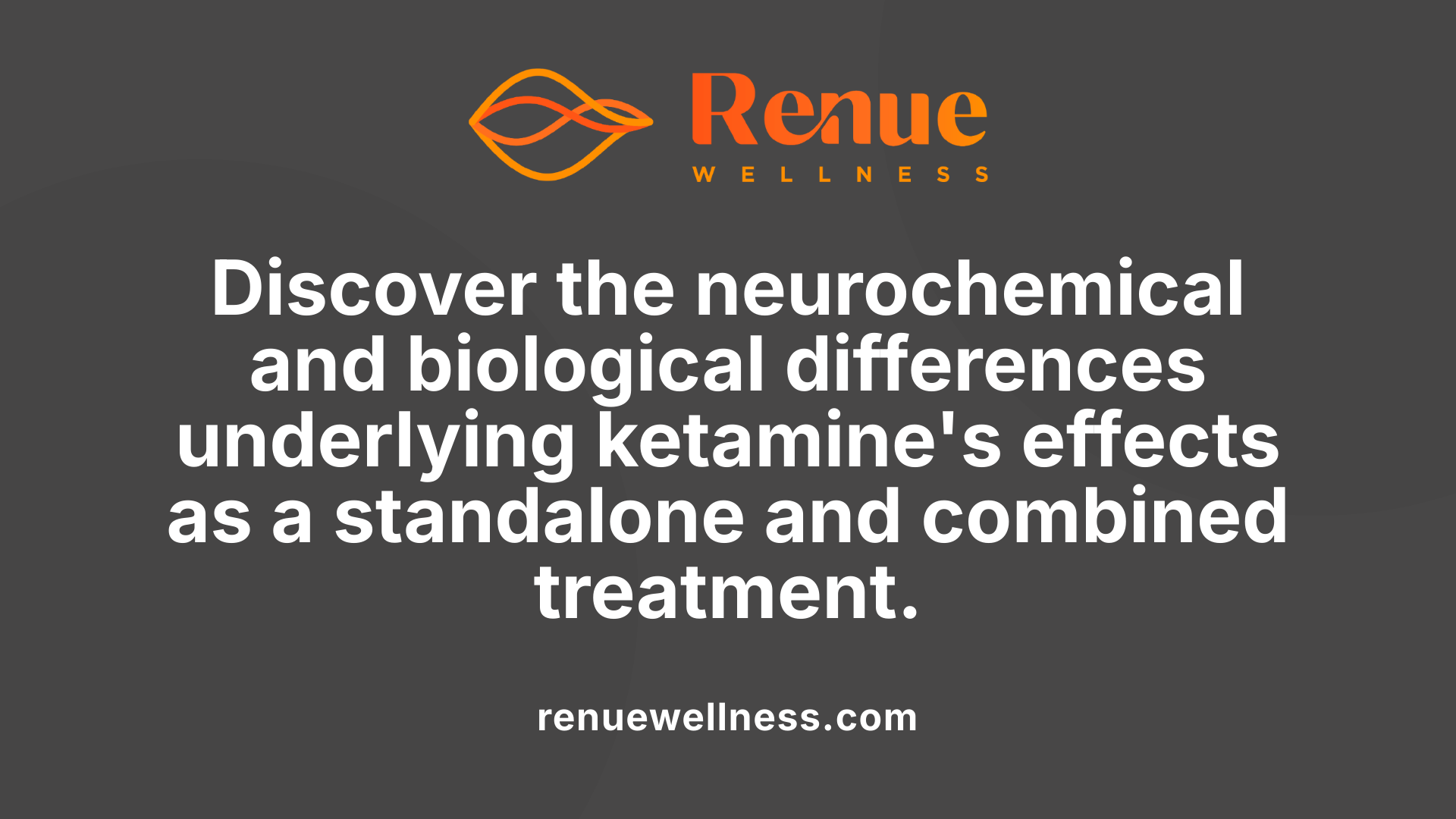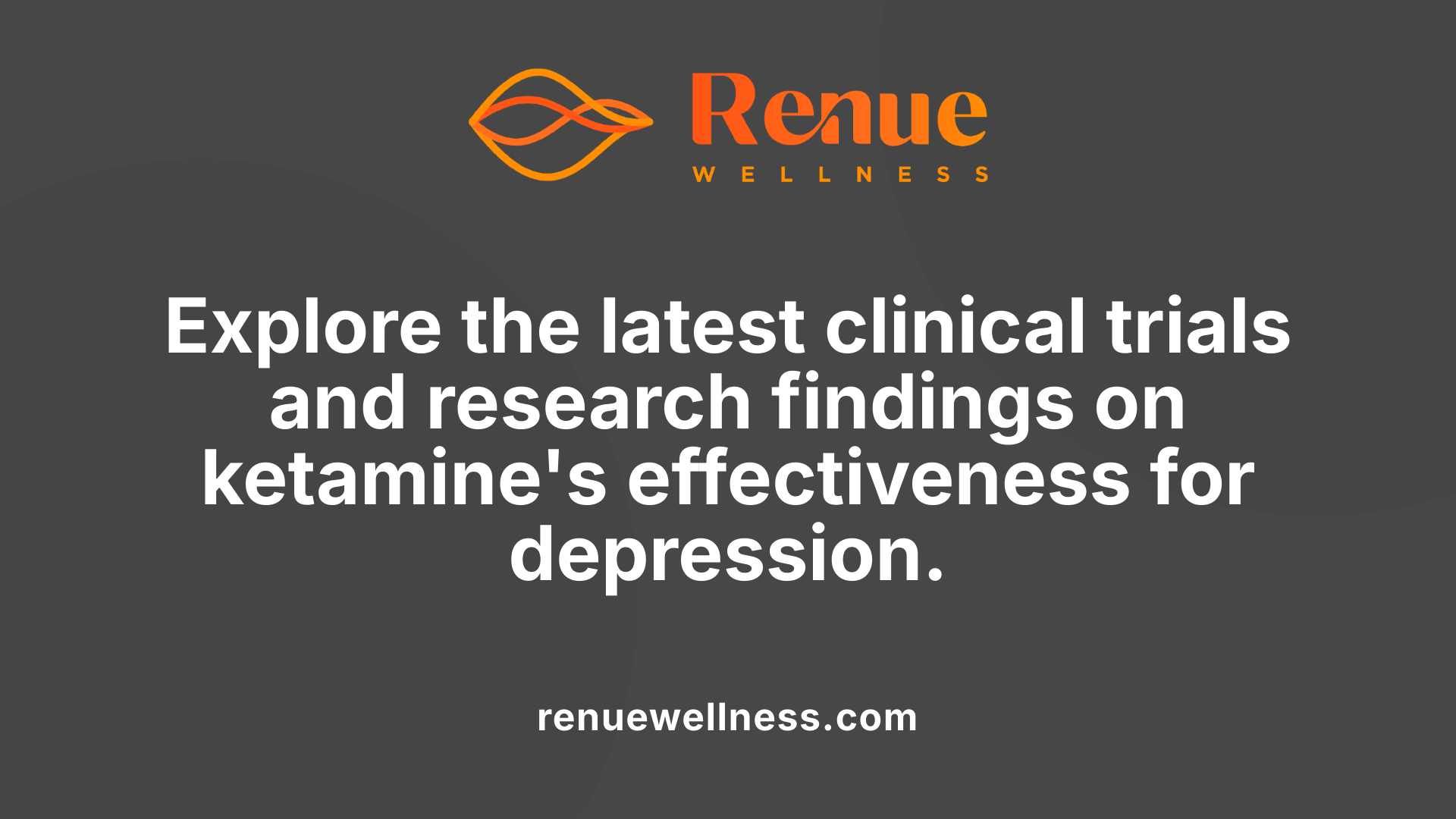Ketamine vs. Ketamine-Anti-depressants Combinations


July 17, 2025
Understanding the Debate: Ketamine Alone vs. Combined with Antidepressants
Recent advances in depression treatment have highlighted the potential of ketamine, a drug initially developed as an anesthetic, for rapid relief, especially in treatment-resistant cases. This article explores the complex landscape of using ketamine as a standalone therapy versus in combination with traditional antidepressants, examining mechanisms, efficacy, safety, and scientific evidence to guide clinical decision-making.
Pharmacological Foundations and Mechanisms of Action
How does ketamine therapy compare to traditional antidepressant treatments in terms of benefits and drawbacks?
Ketamine therapy presents a notable contrast to traditional antidepressants, mainly through its rapid onset of action. Patients often experience symptom relief within hours to days following treatment, which is significantly faster than SSRIs and SNRIs that typically require 4 to 8 weeks or longer to produce noticeable effects. This quick response makes ketamine especially promising for urgent cases, such as severe depression associated with suicidal ideation.
Mechanistically, ketamine works primarily by blocking NMDA (N-methyl-D-aspartate) receptors, which leads to a downstream cascade that increases glutamate activity in the brain. This glutamate surge stimulates AMPA receptors, enhances synaptic plasticity, and promotes neural growth. These processes are believed to underpin its rapid antidepressant effects, particularly beneficial for individuals resistant to conventional treatments.
In contrast, traditional antidepressants increase levels of mood-regulating neurotransmitters such as serotonin and norepinephrine, but they often take weeks to reach full effectiveness. Although these medications are well-understood, they can cause side effects like sexual dysfunction, weight gain, and nausea, and may not work for everyone.
While the quick relief provided by ketamine is a major advantage, it also introduces some safety considerations. Its short-lived effects mean repeated treatments are often necessary, raising concerns about potential dependence, addiction, hallucinations, and cognitive impacts. Long-term safety data are scarce, and the risk of misuse remains a concern.
Traditional antidepressants have a well-established safety and efficacy profile, are more accessible, and usually covered by insurance. However, their delayed onset can delay relief for patients in critical need. Ultimately, the choice between ketamine and conventional treatments depends on individual patient situations, response history, and resource availability.
| Aspect | Ketamine Therapy | Traditional Antidepressants | Notes |
|---|---|---|---|
| Onset of efficacy | Hours to days | Weeks to months | Faster with ketamine |
| Mechanism | NMDA receptor antagonism, glutamate surge | Serotonin and norepinephrine reuptake inhibition | Different neurotransmitter targets |
| Delivery method | Intravenous, nasal spray, oral (research) | Oral pills, patches | Varies in administration |
| Side effects | Dissociation, hallucinations, transient blood pressure increase | Sexual dysfunction, weight gain, nausea | Side effect profiles differ |
| Long-term safety | Limited data, potential misuse | Well-understood, long history | Caution with repeated use |
How does ketamine interact with other medications, and what considerations are there?
When used alongside other medications, ketamine generally exhibits minimal serious adverse interactions, but some specific considerations are noteworthy.
Ketamine does not typically interact negatively with SSRIs like escitalopram and sertraline. In fact, it may enhance their antidepressant effects. Since ketamine is processed by liver enzymes CYP2B6 and CYP3A4, inhibitors of these enzymes—such as some SSRIs (paroxetine, fluoxetine, fluvoxamine) and SNRIs (venlafaxine)—could theoretically increase ketamine’s bioavailability. However, current evidence suggests any such increases are unlikely to be clinically significant.
Combining ketamine with SNRIs is generally safe but may cause transient increases in blood pressure due to sympathetic nervous system activation. This should be monitored, especially in patients with cardiovascular risks.
For other antidepressants:
- TCAs, like nortriptyline, can be used with caution as they might cause cardiovascular effects or sedation.
- MAOIs (e.g., tranylcypromine) have not shown adverse interactions like serotonin syndrome in studies, but clinicians remain cautious.
- Bupropion is well-tolerated with ketamine, with mild increases in blood pressure being the main concern.
- Mirtazapine in low doses appears safe, but higher doses may lead to overlapping sedation.
- Lithium does not significantly interact with ketamine, nor does it improve its efficacy.
- Lamotrigine may attenuate some ketamine effects, leading to clearer consciousness and possibly reducing psychosis risk.
- Benzodiazepines can reduce ketamine’s antidepressant effects but increase sedation and respiratory depression; nonetheless, safety in concurrent use has been observed.
| Medication | Interaction Type | Potential Risks | Notes |
|---|---|---|---|
| SSRIs (e.g., fluoxetine) | Enzyme inhibition | Increased ketamine levels | Effects likely minimal |
| SNRIs (e.g., venlafaxine) | Enzyme inhibition | Increased bioavailability | Monitor blood pressure |
| TCAs (e.g., nortriptyline) | Caution (cardiovascular effects) | Cardiovascular stress | Use with caution |
| MAOIs | No proven issues | Risk of hypertensive crisis | Cautious use advised |
| Bupropion | Tolerated | Mild blood pressure increases | Safe for most |
| Mirtazapine | Safe in low doses | Sedation, overlap effects | Adjust doses accordingly |
| Lithium | Minimal interaction | None observed | No enhancement of effects |
| Lamotrigine | Potential antagonism | Reduced ketamine effects | Use cautiously |
| Benzodiazepines | Reduce efficacy | Increased sedation | Use Monitoring |
Ketamine’s multifaceted actions on neurochemical systems and receptor sites contribute to its rapid antidepressant effects, but understanding its interactions with other medications helps optimize safety and efficacy. Close monitoring and personalized treatment planning remain essential for patients undergoing ketamine therapy.
Comparative Efficacy: Monotherapy vs. Combination Therapy

What are the pharmacological interactions, mechanisms, and efficacy of ketamine alone versus in combination with antidepressants?
Ketamine, a drug initially developed as an anesthetic, has gained prominence for its rapid antidepressant effects, especially in treatment-resistant depression. Its primary action involves blocking NMDA receptors as an antagonist, which triggers downstream effects that promote neural plasticity. Specifically, ketamine stimulates the activation of AMPA receptors, increases glutamate release, and enhances signaling pathways like BDNF and mTOR, leading to synaptic growth and strengthened neural circuits.
When used alone, ketamine can produce rapid and significant relief from depressive symptoms, often within hours, with response rates reported between 29% to 79%. Its effects are transient, typically lasting a week or slightly longer, but repeated infusions are being studied to maintain these benefits.
The mechanisms of ketamine’s action differ from traditional antidepressants, which mainly increase monoamine levels over weeks. Combining ketamine with other antidepressants generally does not result in detrimental interactions. For instance, SSRIs, SNRIs, and bupropion are often safely administered alongside ketamine and may even augment its therapeutic effects.
Pharmacological interactions vary among medications. Benzodiazepines can reduce ketamine's efficacy by enhancing GABAergic inhibition, potentially dampening glutamate activity. Lamotrigine, which suppresses glutamate release, may antagonize some effects of ketamine, although findings are inconsistent.
In contrast, mood stabilizers like lithium do not significantly interact with ketamine nor enhance its effects, making them a safer combination when necessary. Similarly, while MAOIs such as tranylcypromine have not shown substantial adverse interactions, caution is always advised due to their broad pharmacodynamic profiles.
Overall, understanding these mechanisms allows clinicians to tailor treatments—using ketamine either alone or in conjunction with other antidepressants—to maximize efficacy and minimize risks. Careful consideration of potential interactions ensures safe and effective management of depression, especially in cases unresponsive to conventional therapies.
Neurochemical and Biological Distinctions

What are the biological and neurochemical differences between ketamine as a standalone treatment and its combination with antidepressants?
Ketamine, when used as a solo treatment for depression, acts primarily by targeting the glutamate system. It acts as a non-competitive antagonist of NMDA receptors on neurons, blocking these excitatory channels. This blockade initiates a cascade of downstream effects, leading to increased glutamate release and enhanced activity at AMPA receptors. Activation of these receptors promotes synaptic plasticity — the brain’s ability to adapt by forming new connections — and stimulates pathways involving mTOR (mammalian target of rapamycin) and BDNF (brain-derived neurotrophic factor). These mechanisms contribute to rapid antidepressant effects, as they increase synaptic density and promote neurogenesis.
Furthermore, ketamine has anti-inflammatory properties. It reduces microglial activation, decreases pro-inflammatory cytokine production, and helps normalize stress-related neuroendocrine disturbances. These neuroimmune modulatory effects are particularly relevant given the role of neuroinflammation in depression.
When ketamine is combined with traditional antidepressants, such as SSRIs (selective serotonin reuptake inhibitors), the neurochemical landscape becomes more complex and potentially more beneficial. SSRIs increase serotonergic activity by inhibiting the reuptake of serotonin, leading to elevated levels of this neurotransmitter in the synaptic cleft. Over time, this enhances neuroplasticity and stabilizes mood.
The combination of ketamine with SSRIs or SNRIs (serotonin-norepinephrine reuptake inhibitors) may generate synergistic effects. While ketamine stimulates glutamate-mediated neuroplasticity rapidly, serotonergic agents support longer-term stabilization and neurogenesis. This cooperative interaction can lead to more sustained mood improvements and might extend the duration of ketamine’s benefits.
From a neurochemical perspective, ketamine’s effects include increased release and activity of dopamine, serotonin, and norepinephrine by indirectly promoting their release through the disinhibition of glutamatergic neurons. The adjunct use of antidepressants mainly amplifies serotonergic and noradrenergic signaling, which complements the rapid glutamate-focused mechanisms of ketamine.
Moreover, research shows that combining ketamine with serotonergic antidepressants does not typically cause adverse interactions. Instead, such combinations may enhance therapeutic efficacy, possibly by addressing multiple neurochemical pathways involved in depression.
In summary, ketamine alone primarily targets the glutamate system to induce rapid neuroplastic changes, while its combination with antidepressants engages serotonergic and noradrenergic pathways. This dual approach may influence neuroinflammation, neurogenesis, and stress-related processes more comprehensively, offering a broader and potentially more durable antidepressant response.
Safety, Risks, and Clinical Outcomes

What are the safety considerations, risks, and clinical outcomes associated with the use of ketamine alone or with antidepressants?
Ketamine has gained prominence as a rapid-acting treatment option for severe and treatment-resistant depression. When used in clinical settings, particularly through monitored intravenous infusion or intramuscular injection, it often produces swift symptom relief. Many patients report significant improvements within hours to a few days, with effects sometimes lasting up to a week or more.
In terms of safety, the short-term profile of ketamine appears relatively favorable when administered properly. Common transient side effects include dissociation, hallucinations, dizziness, nausea, increased blood pressure, and restlessness. These effects are generally mild and tend to resolve shortly after the infusion ends. Moreover, the procedure is typically conducted under close medical supervision to promptly manage any adverse responses.
Despite these benefits, concerns about long-term safety remain. Chronic or repeated use of ketamine has been associated with neurotoxicity, bladder damage, cognitive impairments, and alterations in brain white matter. These adverse effects have been primarily observed in non-medical, recreational use scenarios, but their relevance to controlled clinical settings is still under investigation.
The potential for dependence and misuse is another important consideration. As a drug with dissociative and psychoactive properties, ketamine carries a risk of addiction, especially with repeated or unsupervised use outside medical oversight. Some individuals may develop tolerance or psychological dependence, although, in controlled environments, this risk appears to be lower.
When ketamine is administered alongside antidepressants, some interactions may enhance or diminish therapeutic effects or cause side effects. The combination with SSRIs like escitalopram or sertraline generally does not pose significant risks and may even augment efficacy. However, inhibitors of liver enzymes such as CYP2B6 and CYP3A4, used in some antidepressants, can potentially increase ketamine's bioavailability, though clinical significance is uncertain.
Other drug combinations, such as with SNRIs, TCAs, and bupropion, are usually safe but may lead to transient blood pressure increases, sedation, or cardiovascular effects. High-dose benzodiazepines may reduce ketamine’s antidepressant efficacy but can increase sedation and respiratory depression if used concurrently.
Monitoring during combined therapy should focus on cardiovascular stability, mental status, and potential interactions. Regular follow-up is critical for detecting any emerging adverse effects, especially in long-term or repeated treatments.
Overall, ketamine’s use in depression shows promising rapid benefits; however, clinicians must carefully evaluate individual patient profiles, monitor for adverse effects, and consider long-term risks. Current research highlights the need for further studies into its chronic safety and efficacy, particularly regarding dependency, neurotoxicity, and overall functional outcomes.
| Aspect | Consideration | Additional Details |
|---|---|---|
| Short-term safety | Common adverse effects | Dissociation, hallucinations, increased blood pressure, nausea |
| Long-term risks | Neurotoxicity | Brain structural changes, cognitive impairments |
| Dependency potential | Misuse and dependence | Psychoactive effects may lead to craving, especially with unsupervised use |
| Combination therapy | Drug interactions | Enhanced effects or side effects, requiring monitoring |
| Monitoring | Clinical oversight | Regular assessment of mental state, cardiovascular health, and functional status |
This balanced approach underscores that while ketamine offers a novel and rapid pathway for treating severe depression, awareness of its risks, careful patient selection, surveillance, and adherence to safe protocols are essential to optimize clinical outcomes.
Research Evidence and Clinical Trials on Efficacy and Safety

What scientific research and evidence exist regarding the efficacy of ketamine alone versus in combination with antidepressants for depression treatment?
Extensive research indicates that ketamine provides rapid relief of depressive symptoms, especially in cases resistant to traditional treatments. Clinical trials demonstrate response rates that can range from about 25% to over 70%, with some studies showing significant improvement within hours after administration. These effects are primarily linked to ketamine's action as an NMDA receptor antagonist, which increases glutamate activity and promotes synaptic plasticity.
Ketamine's ability to trigger neuroplastic changes in the brain differentiates it from conventional antidepressants, which typically take weeks to show benefits. Its fast onset of action makes it a promising option for urgent clinical situations, such as suicidal ideation.
Research has also explored the use of ketamine in conjunction with existing antidepressants. Combining ketamine with antidepressants like SSRIs and SNRIs is often safe and may lead to additive effects. For example, some studies found ketamine could augment the efficacy of SSRIs like escitalopram and sertraline, without significant adverse interactions. This combination can be particularly useful where traditional monotherapy has failed.
The FDA-approved esketamine nasal spray exemplifies a targeted treatment derived from ketamine. It is approved specifically for treatment-resistant depression when used alongside oral antidepressants, underscoring the benefit of combination therapy.
Despite promising findings, evidence regarding the long-term benefits and safety of ketamine, whether used alone or with antidepressants, remains limited. Concerns persist about potential dependence, neurotoxicity, and cognitive effects with repeated use. Current data support the need for further rigorous, large-scale studies to determine optimal treatment protocols, long-term safety, and comparative efficacy.
How do findings compare with electroconvulsive therapy (ECT) and other treatment options?
Research comparing ketamine with ECT—a highly effective treatment for severe depression—reveals nuanced results. In studies like the ELEKT-D trial, ketamine showed greater response rates among outpatients and those with moderately severe depression, whereas ECT exhibited higher early response rates in very severe cases. Over time, however, both treatments led to comparable improvements.
Ketamine tends to produce faster symptom relief than ECT, especially within hours to days. ECT, while more traditionally effective for extreme cases, requires multiple sessions and carries risks of memory impairment. Conversely, ketamine's rapid action and fewer sessions make it appealing, especially for urgent symptom management.
Limitations in studies include small sample sizes and varying patient characteristics, making it difficult to establish definitive superiority. Nonetheless, preliminary data suggests ketamine could serve as an alternative or adjunct to ECT, especially in patients who cannot tolerate ECT.
Limitations and future research directions
Although current evidence supports ketamine's rapid antidepressant effects, several limitations hinder comprehensive understanding. Many trials have small sample sizes, short follow-up periods, and lack diverse populations. Consequently, generalizing findings to broader patient groups remains challenging.
Long-term safety data are scarce, raising concerns about potential adverse effects from repeated or chronic use, such as neurotoxicity, urinary issues, and cognitive impairment.
Future research should focus on large, randomized controlled trials to compare different administration protocols—single versus repeated doses—and their long-term outcomes. Investigating optimal dosing, treatment duration, and patient selection criteria is essential.
Moreover, exploring the mechanisms underlying sustained antidepressant effects and potential relapse could inform combination strategies with other treatments. Study designs incorporating biomarkers and neuroimaging may also help tailor personalized treatment approaches.
In summary, while the evidence firmly supports ketamine's rapid efficacy in treatment-resistant depression, its role relative to conventional therapies like ECT and ongoing safety profile require further elucidation through comprehensive research.
Future Directions and Clinical Implications

What are the emerging trends, new treatments, and future research directions related to ketamine and its combinations?
In recent years, the landscape of depression treatment has expanded beyond traditional antidepressants, highlighting novel therapies that target the glutamate system. Among these developments is Auvelity, an oral medication combining dextromethorphan and bupropion. This formulation mimics ketamine's mechanism—acting on NMDA receptors to modulate glutamate—but without many of ketamine’s side effects such as dissociation or hallucinations. FDA approval was based on robust clinical trials demonstrating significant symptom reduction within just 6 weeks, with approximately 40% of patients achieving remission.
Meanwhile, nasal esketamine—an FDA-approved derivative of ketamine—offers a rapid-onset treatment for resistant depression. Its nasal spray formulation facilitates outpatient administration and provides quick symptom relief within hours, making it a valuable option in urgent settings.
Looking ahead, research is heavily focused on understanding which patient groups derive the most benefit from ketamine versus other treatments. Studies are exploring personalized medicine approaches, where genetic, neuroimaging, and biomarker data inform tailored therapy plans. This precision medicine aims to optimize efficacy while reducing adverse effects.
Further investigation is underway into new agents designed to enhance synaptic plasticity—key to ketamine’s antidepressant effects—such as drugs targeting mTOR pathways or neurotrophic factors like BDNF. These efforts could produce longer-lasting benefits and lower relapse rates.
Beyond pharmacology, innovations in delivery methods and monitoring protocols are anticipated to improve safety and accessibility. For example, developing oral formulations with rapid onset or establishing outpatient clinics equipped to facilitate safe infusions will broaden treatment options.
Institutional and regulatory frameworks are evolving to oversee these advancements. This includes devising guidelines to prevent misuse, address ethical concerns, and ensure equitable access. Particularly in regard to long-term safety, ongoing studies are crucial to confirming that repeated or sustained use of these treatments does not cause neurotoxicity or cognitive impairment.
Overall, future research is driving a shift toward personalized, mechanism-based therapies. The integration of biomarkers, genetic data, and advanced neuroimaging will enable clinicians to select the most suitable interventions, ultimately improving outcomes and patient quality of life.
How are personalized medicine considerations shaping the future of ketamine-based treatments?
Personalized medicine is becoming central to depression therapy, especially with agents like ketamine and its derivatives. Variability in response can be significant, influenced by genetic factors, brain morphology, and neurochemical profiles. For instance, genetic markers related to NMDA receptor variants or BDNF gene polymorphisms may predict who responds best to ketamine.
Neuroimaging techniques, such as functional MRI, are used to identify neural circuit dysfunctions associated with depression and treatment response. Patients exhibiting specific patterns of brain activity may benefit more from glutamate modulators than from conventional therapies.
Clinical studies are increasingly incorporating biomarker assessments to refine treatment algorithms. These include measuring glutamate levels, neurotrophic factors, or inflammatory markers, which can guide decisions on whether to proceed with ketamine-based therapies.
Implementing personalized approaches also involves monitoring side effects and adjusting doses individually. For example, patients with cardiovascular risks might require modified dosing strategies to mitigate transient blood pressure elevations.
By tailoring treatments based on individual profiles, clinicians aim to maximize efficacy, minimize adverse effects, and enhance long-term remission. This approach leads to more effective management of treatment-resistant depression, reducing trial-and-error therapy methods.
What are the regulatory and ethical issues in ketamine-based treatments?
As ketamine and its derivatives become more prevalent in depression management, regulatory and ethical considerations are increasingly prominent. Ensuring patient safety involves strict oversight of administration protocols, especially for repeated infusions which may carry risks like neurotoxicity or dependence.
One major concern is the potential for misuse and abuse. Ketamine’s history as a recreational drug under names like K or Special K necessitates robust controls and education to prevent diversion and addiction.
Regulatory agencies are working to develop standardized guidelines for safe prescribing, monitoring, and reporting adverse events. These include establishing appropriate dosage ranges, screening protocols, and follow-up procedures.
Ethically, equitable access is a challenge. The high cost of ketamine and proprietary formulations like esketamine can limit availability, raising questions about justice and healthcare disparities.
In addition, the rapid-acting nature of these treatments may pressure clinicians into off-label prescribing options without sufficient data on long-term safety. Transparency in research and conflicts of interest in commercial interests are ongoing concerns.
Finally, as personalized medicine advances, the ethical use of genetic and biomarker data must be managed carefully to protect patient privacy and prevent discrimination.
In conclusion, ongoing research, clear regulatory frameworks, and ethical vigilance are essential to integrating ketamine-based therapies responsibly into mainstream mental health care. These steps will help maximize benefits while safeguarding against potential harms, ensuring that innovations serve all patients effectively and ethically.
Concluding Perspectives on Ketamine Strategies for Depression
While ketamine offers rapid relief for treatment-resistant depression, its optimal use—whether as a standalone treatment or in combination with traditional antidepressants—remains under active investigation. Monotherapy may provide faster symptom alleviation, but combination therapies could potentially prolong benefits and reduce certain adverse effects. Ongoing research, clinical trials, and real-world studies will continue to clarify these approaches, with a focus on safety, efficacy, and personalized treatment strategies to better serve patients facing severe depression.
References
- Interactions between ketamine and prescription antidepressants
- Ketamine Therapy vs. Traditional Antidepressants - Bold Health
- Ketamine as Antidepressant? Current State and Future Perspectives
- Bridging rapid and sustained antidepressant effects of ketamine
- Pharmacodynamic Interactions Between Ketamine and Psychiatric ...
- Ketamine and rapid antidepressant action: new treatments ... - Nature
- Ketamine vs Traditional Antidepressants - Which Is Right for You?
- Advancing Auvelity, a Novel Antidepressant Alternative to Ketamine
Recent Posts
Conditions Treated
AnxietyDepressionOCDPTSDPostpartum DepressionPain ManagementSubstance AbuseSuicidal IdeationOur Location


